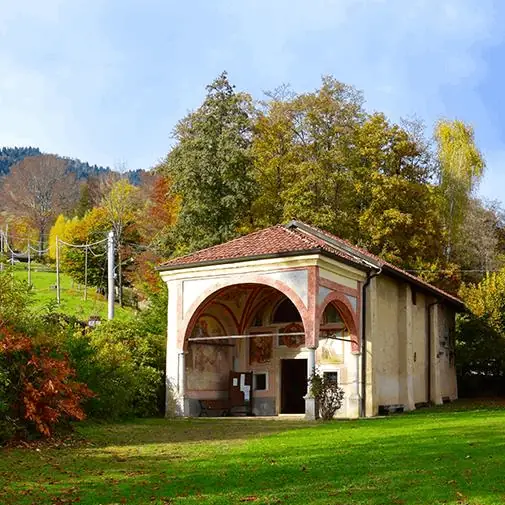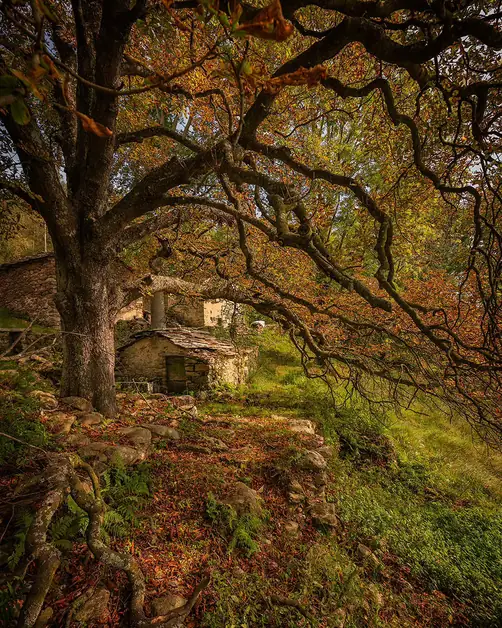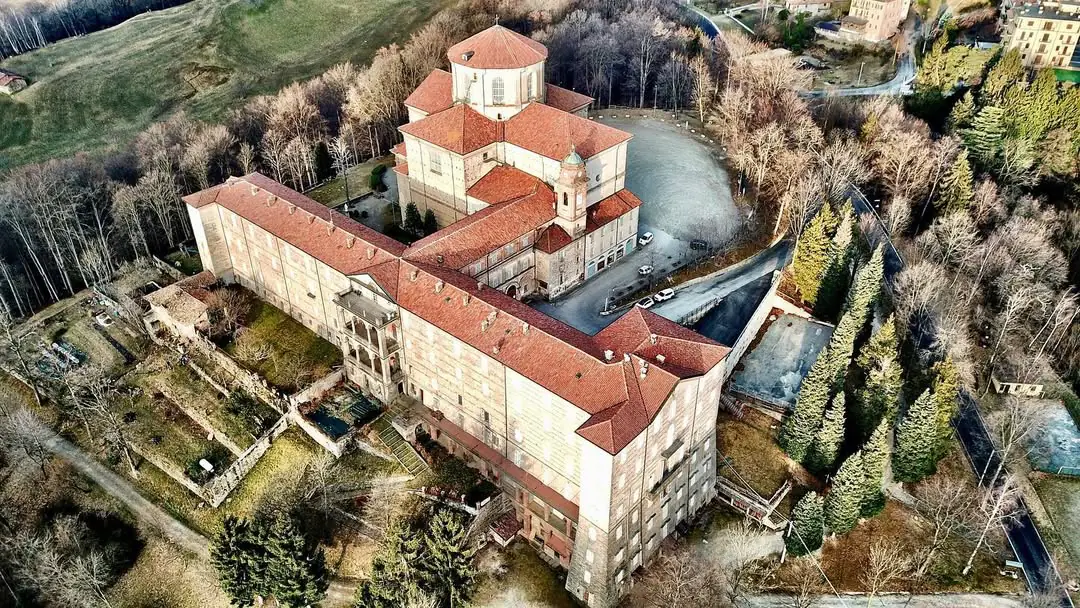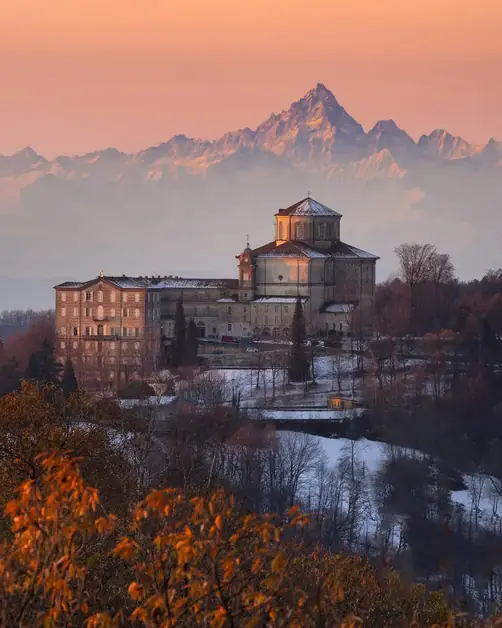The Sanctuary of Brughiera between faith and nature
The Sanctuary of Brughiera is a place of faith immersed in nature.

Where is the Sanctuary of Brughiera and why is it so loved?
The Sanctuary of Our Lady of Brughiera is located in Bulliana, a hamlet of Trivero Valdilana, in the heart of the Biella Prealps. It is immersed in a landscape of woods and pastures, over 800 meters above sea level, and represents one of the most suggestive places of Marian devotion in Piedmont. Surrounded by lush nature and mountain air, the sanctuary offers visitors an experience of peace, silence, and spirituality, open to all throughout the year. It is not only a pilgrimage destination but also a reference point for those wishing to discover the history, art, and legends that have intertwined around this sacred place for centuries.
What is the legend that gave rise to the Sanctuary of Brughiera?
Popular tradition tells that, in the sixteenth century, a mute shepherdess was grazing her flock in the Brughiera area when, suddenly, the Virgin Mary appeared to her. During this apparition, the young girl miraculously received the gift of speech and hearing. The miraculous event quickly spread among the local inhabitants, who decided to build a church in honor of the Madonna at the site of the apparition. This first construction, now known as the Old Church, quickly became a site of popular devotion and a spiritual reference point for the surrounding communities. Subsequently, the growing influx of worshippers led to the construction of a second, larger, and more majestic church: the Great Church, built in the seventeenth century.
What does the Old Church represent?
The Old Church of the Sanctuary of Brughiera preserves the heart of the Marian tradition of the place. Inside, there is a marble niche that houses the wooden statue of the Madonna, known as the Madonna of Brughiera. The architectural simplicity of the church reflects the deep spirituality of the alpine communities, where faith manifests itself through devotion and gratitude towards nature and divine protection. This church represents the ideal conclusion of the Via Crucis, a devotional path that starts from the parish church of Bulliana and leads to the sanctuary.
What is the Via Crucis that leads to the Sanctuary?
The Via Crucis is a spiritual and naturalistic itinerary that accompanies pilgrims along a mule track that gently ascends towards the sanctuary. Along the way, at regular intervals, there are fourteen chapels, built starting from 1833, each dedicated to a station of the Passion of Christ. Walking this Via Crucis means experiencing a moment of reflection and gathering, immersed in a landscape that combines spirituality with the unspoiled beauty of chestnut woods and mountain meadows. The path is appreciated not only by pilgrims but also by hikers seeking an authentic connection with nature and local religious tradition.
What are the architectural features of the Great Church?
The Great Church of the Sanctuary of Our Lady of Brughiera is an extraordinary example of alpine baroque architecture. The facade, sober and harmonious, gives way to an interior of great decorative richness. The three naves are divided by two orders of stone columns, which give the environment a sense of majesty and balance. The vaulted ceilings are frescoed by the painter Pietro Lace of Andorno (1648-1733), who managed to combine the elegance of Piedmontese baroque with the spirituality of the Marian theme. These frescoes, still in excellent condition today, represent one of the most important testimonies of sacred art in Biella from the seventeenth century.
How does the Sanctuary of Brughiera fit into the context of the Zegna Oasis?
The sanctuary is located in the heart of the famous Zegna Oasis, a natural area wanted by entrepreneur Ermenegildo Zegna and dedicated to the enhancement of the Biella territory. Immersed among chestnut, beech woods, and alpine pastures, the Sanctuary of Brughiera offers a peaceful stop for those walking the hiking trails of the Oasis. The surrounding environment, cared for and protected, contributes to making this place a perfect fusion of spirituality and nature, where the silence of the mountain merges with the song of the wind and the scent of wood and resin.
Is the Sanctuary open all year round?
Yes, the Sanctuary of Brughiera is open all year round and welcomes pilgrims and tourists in every season. In spring and summer, the surrounding meadows are colored with green and flowers, while in autumn the woods offer a palette of warm and enveloping colors. In winter, the snow makes the atmosphere even more intimate and suggestive. Throughout the year, religious functions, Marian celebrations, and spiritual walks are organized, attracting worshippers from all over Piedmont and even from nearby regions.
Does the Sanctuary of Brughiera belong to a broader religious path?
Yes, together with the Sanctuary of Banchette (Bioglio), the Sanctuary of Mazzucco (Camandona), and the Sanctuary of Brugarola (Ailoche), the Sanctuary of Brughiera is part of the group of minor sanctuaries of Biella. These sacred places wind along the CoEUR (European Paths) hiking and devotional itineraries and are also connected to the Cammino di San Carlo, an ancient path that unites art, faith, and nature. For modern pilgrims, these itineraries represent a way to rediscover the authentic meaning of the journey: an inner, slow, and profound journey through the landscapes of the Biella Prealps.
Why visit the Sanctuary of Brughiera today?
Visiting the Sanctuary of Brughiera means immersing oneself in a dimension where history intertwines with legend and faith merges with nature. It is a place where architectural simplicity accompanies a deep spiritual intensity. Whether arriving as a pilgrim, hiker, or simple visitor, the sanctuary welcomes everyone with the same serenity. The two churches, the Via Crucis, the woods of the Zegna Oasis, and the tale of the miraculous shepherdess make this place a symbol of the bond between man, nature, and the divine. In the silence of Brughiera, among the scent of chestnuts and the song of birds, one can still perceive today the strength of legend and the devotion of centuries of history.


